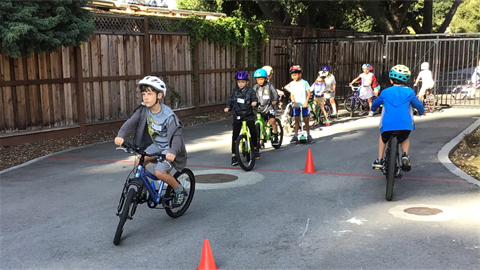Using bicycle and pedestrian rodeos to teach road safety skills
Published on October 02, 2024

Bicycle and pedestrian rodeos are interactive, educational events designed to teach children essential skills for navigating roads and sidewalks. Typically held in schools or community spaces, bicycle and pedestrian rodeos provide a fun and engaging way for kids to learn how to stay safe while walking or bicycling.
This article dives into the purpose of these safety events and how to successfully organize and deliver one yourself!
What are bicycle and pedestrian rodeos?
A bicycle and pedestrian rodeo is an organized safety “fair” where children rotate through various stations that simulate real-world traffic scenarios. This allows participants to practice skills like following traffic signs, using crosswalks, and wearing protective gear in a safe and fun environment.
The main goals of bicycle and pedestrian rodeos include:
- Teaching road safety to prevent injuries.
- Practicing safe biking and walking skills in a safe protected environment.
- Encouraging the use of helmets, reflectors and other safety gear.
- Instilling lifelong habits of safe pedestrian and bicyclist behavior.
- Promoting the benefits of walking and biking for health and the environment.
Typical rodeo audience
Rodeos are typically oriented towards school-aged children, between five and 14 years old. This age group is most at risk when walking or bicycling due to their inexperience with traffic rules.
Format of bicycle and pedestrian rodeos
The structure of bicycle and pedestrian rodeos typically includes several stations where participants engage in different activities. Small groups of children rotate through these stations, which are designed to simulate real-life traffic situations, allowing them to practice crossing streets, obeying traffic signals and navigating intersections. For example, one pedestrian station may teach kids how to cross a street using a sidewalk, while a bicycle station may involve a course where participants practice hand signals, stopping at stop signs and making turns.
Note: for bicycling courses, students can either bring their own bicycles or the rodeo organizers can provide them. Bikes are inspected for safety and helmets are fitted properly before participants start the course. Students can also bring their scooter if they don’t have a bicycle.
Rodeos organized through a school typically take place during the school day, but rodeos can also be a citywide event held at a public space, such as a large park.
Skills taught
The skills taught vary by age group but generally include:
- Helmet fitting and the importance of wearing one.
- Bike control skills, such as steering, braking and balancing.
- Hand signals for turning and stopping.
- Recognizing and obeying traffic signs and signals.
- Crossing streets safely using crosswalks.
- Identifying safe walking routes.
- Awareness of traffic hazards, such as parked cars, garbage bins and driveways.
Skills can be tailored to the participants’ ages, with younger children focusing on pedestrian safety and older kids learning more advanced bicyclist skills.
How to organize a bicycle and pedestrian rodeo
Rodeos are often organized by a combination of community members, including schools, public health departments, and transportation safety organizations. Law enforcement officers also often play a key role in delivering the training, as do educators and safety professionals.
Organizing a rodeo requires some planning and collaboration between community partners. Key steps include:
- Select a location – A large, open space like a school blacktop or community center parking lot works best. Ensure your space has enough room to set up stations, mock streets, crosswalks and bicycling courses.
- Recruit volunteers – Volunteers may include school staff, parents, law enforcement officers and local community members.
- Partner with local organizations – Local bike shops and advocacy groups, health departments or traffic safety organizations may help provide resources like bicycles, helmets, traffic cones and safety gear.
- Promote the event – Flyers, school newsletters, and social media posts can spread the word to students and parents.
- Create a curriculum – Ensure that your rodeo covers critical safety topics relevant to your community, such as local traffic laws or common pedestrian hazards. Many resources already exist (see below) to help you put together bike and pedestrian rodeo lessons adapted to your school.
More resources:
Watch this webinar hosted by the Bicycle Coalition of Maine on how to organize a Bicycle Rodeo. View the presentation here.
View the Oregon Department of Transporation Safe Routes to School: SRTS Pedestrian Drill Guide.
View the Oregon Department of Transporation Safe Routes to School: SRTS Bicycle Drill Guide.
Bicycle and pedestrian rodeos are a valuable tool in promoting traffic safety among school children! If you are interested in organizing your own rodeo and have questions, please feel free to contact the Menlo Park Safe Routes to School coordinator at saferoutestoschool@menlopark.gov.